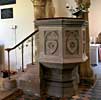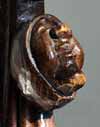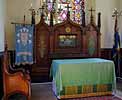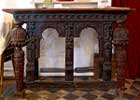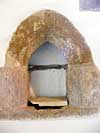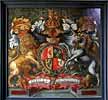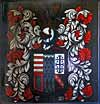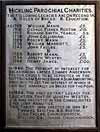For this church:    |
Hickling St LukeFeatures and Fittings
The large stone font dates back to the early 14th century, though it was probably altered in the Reformation period. It is octagonal and has a shield on each side panel and angels under the bowl, but has clearly been recut, perhaps in the 19th century. The knob on the wooden font cover is dated 1665. In 1894 the stone pulpit was completed with the addition of the staircase.
'HF' was Henry Faulks, churchwarden, and 'RB' was Richard Blower, the carpenter who made it. The pews are Victorian and have wooden kneelers.
Medieval carvings in the shape of heads on the bench ends and poppy heads of the stalls in the choir have largely been defaced either in the Reformation or the Civil War period by iconoclasts.
The reredos dates back to the Victorian period and is reputed to have been carved by a local craftsman. It has the Supper at Emmaus painted on it. Inside the entrance to the church to the right is a stand supported by two legs from a four-poster bed topped by some ornamental Victorian woodwork. To the left of this on the wall is the war memorial for village men killed in the two world wars. On either side of the central aisle of the church and attached to two pews are the churchwardens' wands introduced in the 1980s by Peter Harrison, the then rector. The rector's churchwarden's wand has a brass mitre on the top and the people's has a crown. Originally such wands or staves had sharp ends and were used for prodding people who had fallen asleep in sermons and before that when fights broke out on church premises. In 1620 George Greene, the then curate, had Richard Knutton of Hickling presented before the Ecclesiastical court for disturbing him during his sermon. On another occasion a parishioner tried to pull a churchwarden out of his seat. At that period there were no pews and the wealthier folk provided their own seats. There is a piscina at the east end of the south aisle south wall. Opposite the piscina is a square aumbry.
At the back of the church between the pews is a door with a step up into the tower. In the south-west corner there is a doorway opening up on a spiral staircase leading to the upper levels of the tower; on the roof is a weather vane with a cockerel painted gold. Over the stair doorway at ground level is the carving of a man's face with heavily weathered nailhead ornament to either side.
In the north-west corner there is a small window beside which is the shield from Nicholas Penny's coat of arms. He was rector from 1720 to 1730 when he was appointed Dean of Lichfield. During his time the oil paintings of the Royal Coat of Arms of George II and the arms of Queens' College, Cambridge were commissioned, presumably by the college to make it clear that they held the advowson. The college arms are those of Margaret of Anjou, wife of King Henry VI, who founded the college in 1448. The paintings now hang in the vestry and an inscription beneath them reads:
On the south wall of the room there is a list of charitable benefactors. The charity minute books detail regular gifts of bread to less well off villagers, who on one occasion included the rector's wife, but by the 1980s there was a strong risk that recipients might take offence at being thought of as poor, and inflation had substantially reduced the amount of bread which could be bought with the interest. The Charity Commissioners gave permission for the two charities to be wound up and the capital to be applied in such suitable manner as was thought appropriate, which resulted in the purchase of books for the Sunday School and £40 being paid to a charity for the poor in Nottingham. As is noted on a brass plaque, Betsy Collishaw's £100 bequest in 1921 was expended on installing electric lighting in the church. Her husband William's bequest of £200 for general church maintenance on condition that the church wardens should maintain the graves of himself, his wife and members of their families fell in to the general funds of the PCC when these conditions could no longer be complied with because no one could remember which graves were referred to. These Collishaws were only distantly related to the family still living and farming in the village. The list of charities only lists endowments and omits any mention of large numbers of bequests to the poor, the church and the mending of the causey (causeway or Main Street) in the 16th and early 17th centuries. On the east wall of the south aisle is a brass plaque detailing the three 19th century restorations. It reads: |



